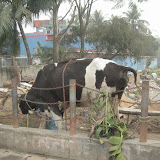I was not able to post anything yesterday because the internet was down. Apparently, there was a problem with the submarine cable that supplies Bangladesh. Yet another thing that is completely different.
Yesterday afternoon, Anne and I headed to a gift shop that is run by an NGO that promotes development in the rural communities of Bangladesh. The shop is called Aarong; the NGO is BRAC. http://www.brac.net/ It is a lovely shop that serves two purposes - it provides rural Bangladeshis access to the markets of Dhaka, and it is a convenient place for visitors to purchase gifts and souvenirs. The trip there and back was a typical drive in Dhaka, which is just plain crazy! There are some stories posted in separate entries.
All three of us (Anne, Sam, and I) had a bit of a break down after all this travel and sightseeing. So, we opted for a night in. That is quite easy to do in Dhaka, since there is not much in the way of nightlife.
Today, Anne and I took a tour of Old Dhaka. That was quite an experience. We are staying in Gulshan, which is new and where most foreigners live. Old Dhaka is pure Bangladesh. The crowds were small, which worked in our favor since we were only surrounded by locals just once on our trip. Once we entered old Dhaka, I knew we weren't in Kansas anymore. The electrical infrastructure is, quite literally, hanging from the awnings of shops and windows of apartments. The sea of rickshaws became an all-encompassing deluge. The density of people must have doubled. It was morning, so the numerous shopkeepers were setting up there shops. As we moved through the city, it was obvous that the merchants were divided into rough districts. Most of the fruit vendors were located in one area, electronics in another. The main product for sale seems to be fabric. There was a very large area devoted to fabric sales. Within that district, there seemed to be subdistricts that specialized on particular patterns and threads. Each shop was a cramped stall, with several stalls crammed into one building. There were countless alleys and sidestreets. We saw an amazing number of rickshaws which were carrying an amazing load of goods.
We also visited the main port of Bangladesh, Sadarghat. The water is low this time of year and it is "cold", so there were no throngs of swimmers, but there were throngs of boats. There were small wooden taxi boats and large vessels dedicated to transporting garment workers to Dhaka from remote villages downriver (more on that later). The port was tiny, packed, and crazy. But, the most impressive sight were the open air schools. These schools have been founded by charitable organizations to educate the many children who live and work in Dhaka. Children who work in nearby shops, factories, and the ships stop by these schools during their work break. It is very easy to underestimate how fundamental such efforts seem to be in changing some of the darker side of Bangladesh. Without education, these children would have very little chance of upward mobility. Anne knows a woman who has helped to deliver these programs in Dhaka. She reports that these childen, many around 10 years old, have made their way to Dhaka on their own and are creatively seeeking employment and survival. They possess an innate creativity and street smarts that could be put to fantastic use with some education.
The most striking thing about Old Dhaka is that it is clear that this area of the world is the crossroads of our modern economy. On our way to the area, we passed several garment factories. There are photos in the linked album. These clothes are all being made for export (check your labels, at least one item you own is probably from Bangladesh). The old center iteself is buzzing with activity to support the garment industry. In contrast, there is an entire district that is dedicated to recycling old clothing - most of which has been reclaimed from the west. Many of the clothes you drop in donation bins end up in places like this. They are sorted, with the best items sent to a factory to be refurbished and the rest sent to manufacturing plants to be used as rags. This is just a drop in the proberbial bucket of recycling here. On every corner you see a new example, people rummaging through garbage piles, rickshaws loaded down with old plastic bags and cardboard, shops filled with ancient ceiling fans. Even the cars are recycled! One could look down on this cycle and assume it is evidence of western imperialism, and maybe it is. To me it seems like we are at the point where the circle of life becomes a continuous cycle. The old comes in and the new comes out - perhaps in evidence more here than anywhere in the west.
Tonight, we went to a local restaurant. It was my first trip out on the roads of Dhaka. Thankfully, the river of cars had abated. But, the rickshaws were in full effect. Without lights, they formed and erie snake of life on the edges of the road. It was quite disconcerting.
This is trully a fascinating city. It is completely overwhelming, but also fascinating. I don't think this trip would be psychologically possible without Anne and Randy's comfortable home, their driver, and the cold Heineken in the refrigerator. There is some nice shopping too.
Wednesday, February 7, 2007
Subscribe to:
Post Comments (Atom)

No comments:
Post a Comment